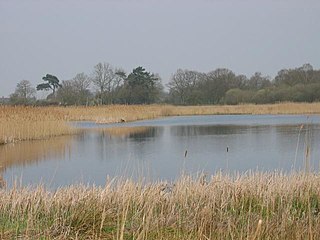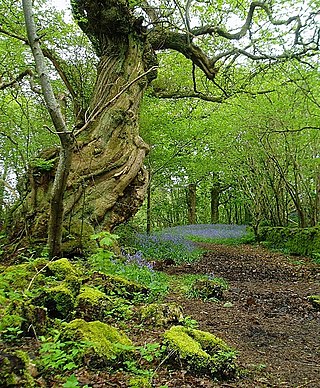
Redgrave and Lopham Fens is a 127 hectare biological Site of Special Scientific Interest between Thelnetham in Suffolk and Diss in Norfolk. It is a national nature reserve, a Ramsar internationally important wetland site, a Nature Conservation Review site, Grade I, and part of the Waveney and Little Ouse Valley Fens Special Area of Conservation. It is managed by the Suffolk Wildlife Trust.

An orchard is an intentional plantation of trees or shrubs that is maintained for food production. Orchards comprise fruit- or nut-producing trees that are generally grown for commercial production. Orchards are also sometimes a feature of large gardens, where they serve an aesthetic as well as a productive purpose. A fruit garden is generally synonymous with an orchard, although it is set on a smaller, non-commercial scale and may emphasize berry shrubs in preference to fruit trees. Most temperate-zone orchards are laid out in a regular grid, with a grazed or mown grass or bare soil base that makes maintenance and fruit gathering easy.

The Somerset Levels are a coastal plain and wetland area of Somerset, England, running south from the Mendips to the Blackdown Hills.

The natterjack toad is a toad native to sandy and heathland areas of Europe. Adults are 60–70 mm in length, and are distinguished from common toads by a yellow line down the middle of the back and parallel paratoid glands. They have relatively short legs, which gives them a distinctive gait, contrasting with the hopping movement of many other toad species.

Wiltshire Wildlife Trust is a conservation charity based in Devizes, England which owns and manages 40 nature reserves in Wiltshire and Swindon. It also works to encourage Wiltshire's communities to live sustainable lifestyles that protect the environment.
The Gloucestershire Wildlife Trust is the Gloucestershire local partner in a conservation network of 46 Wildlife Trusts. The Wildlife Trusts are local charities with the specific aim of protecting the United Kingdom's natural heritage. The Gloucestershire Wildlife Trust is managed by a board of trustees elected from its membership who provide overall direction for the development of the trust and there are advisory committees. The work of the trust is carried out through staff and volunteers.

Durham Wildlife Trust is a registered charity that was established in 1971, originally as the Durham County Conservation Trust, becoming Durham Wildlife Trust in 1988. The Trust operates across the area of the old County Durham, which includes Darlington, Gateshead, South Tyneside and Sunderland.

In the United Kingdom, ancient woodland is that which has existed continuously since 1600 in England, Wales and Northern Ireland. Planting of woodland was uncommon before those dates, so a wood present in 1600 is likely to have developed naturally.

The Cotswold Water Park is the United Kingdom's largest marl lake system, straddling the Wiltshire–Gloucestershire border, north-west of Cricklade and south of Cirencester. There are 180 lakes, spread over 42 square miles (110 km2).

A BioBlitz, also written without capitals as bioblitz, is an intense period of biological surveying in an attempt to record all the living species within a designated area. Groups of scientists, naturalists, and volunteers conduct an intensive field study over a continuous time period. There is a public component to many BioBlitzes, with the goal of getting the public interested in biodiversity. To encourage more public participation, these BioBlitzes are often held in urban parks or nature reserves close to cities. Research into the best practices for a successful BioBlitz has found that collaboration with local natural history museums can improve public participation. As well, BioBlitzes have been shown to be a successful tool in teaching post-secondary students about biodiversity.

The Great Western Ambulance Service NHS Trust (GWAS) was a National Health Service (NHS) trust which provided emergency and non-emergency patient transport services to Bath and North East Somerset, Bristol, Gloucestershire, North Somerset, Swindon and Wiltshire, in South West England. It was formed on 1 April 2006 by the merger of the Avon, Gloucestershire and Wiltshire ambulance services. The ambulance service was acquired by neighbouring Foundation Trust South Western Ambulance Service (SWASFT) on 1 February 2013.

The Biodiversity Heritage Library (BHL) is the world’s largest open access digital library for biodiversity literature and archives. BHL operates as a worldwide consortium of natural history, botanical, research, and national libraries working together to address this challenge by digitizing the natural history literature held in their collections and making it freely available for open access as part of a global "biodiversity community". The BHL consortium works with the international taxonomic community, publishers, bioinformaticians, and information technology professionals to develop tools and services to facilitate greater access, interoperability, and reuse of content and data. BHL provides a range of services, data exports, and APIs to allow users to download content, harvest source data files, and reuse materials for research purposes. Through taxonomic intelligence tools developed by Global Names Architecture, BHL indexes the taxonomic names throughout the collection, allowing researchers to locate publications about specific taxa. In partnership with the Internet Archive and through local digitization efforts, BHL's portal provides free access to hundreds of thousands of volumes, comprising over 59 million pages, from the 15th-21st centuries.

Bechstein's bat is a species of vesper bat found in Europe and western Asia, living in extensive areas of woodland.
Devon Birds, known as the Devon Bird Watching & Preservation Society from its founding in 1928 until it as renamed in 2005, is one of the UK's regional ornithological societies.

St Giles' Church is in the deserted village of Imber, Wiltshire, England, which since 1943 has been within the British Army's training area on Salisbury Plain. The church was built in the late 13th or early 14th century. It is recorded in the National Heritage List for England as a Grade I listed building, and is now a redundant church in the care of the Churches Conservation Trust. It was declared redundant on 1 November 2002 and was vested in the Trust on 14 September 2005. Public access to it is severely restricted due to its military setting.

The biodiversity of Wales is the wide variety of ecosystems, living organisms, and the genetic makeups found in Wales.

Peoples Trust for Endangered Species (PTES) is a charitable organisation registered in England and Wales. It exists to promote the conservation of rare or declining species and habitats in the UK and worldwide through monitoring, public engagement, education, and through the funding of conservation projects and research. It also owns and manages two nature reserves. As of April 2015, PTES has 16 employees, five trustees and coordinates around 24,000 volunteers in the UK. PTES relies on donations from the general public and grants from trusts and foundations to continue its work - it receives no core funding from the UK Government. The organisation has registered charity number 274206.















